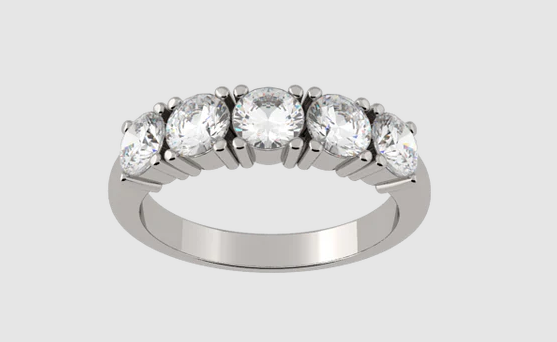Platinum and gold, the two most valuable metals, are the most common choices for eternity rings. What metal your eternity ring is made of will be determined by various criteria. If the diamond eternity ring is going to be worn between the bride’s engagement and wedding bands, it’s best to choose one that coordinates with the rest of her jewellery.
Give your lady a platinum or white gold eternity ring if she likes white metal accessories. If she is more of a purist, then a ring made of yellow gold is the obvious option. The kind of carat is also significant. For example, if her wedding band is 18 karat gold, you should get her a nine karat gold eternity ring, so it doesn’t become scratched.
Eternity Rings Made of Yellow Gold
One classic choice is an eternity ring made of yellow gold. Yellow gold, highly coveted throughout history, is a lovely backdrop for a sparkling diamond. Because of their resistance to corrosion and wear, eternity bands made of 18-karat yellow gold are a great choice. If you’re looking for a low-cost eternity ring, 9k gold bands are a safe bet.
Engagement rings made of white gold.
If you’re looking for a diamond eternity ring but don’t want to spend as much, a white gold one is a beautiful and more inexpensive option than platinum. White gold, the most sought-after precious metal for jewellery, has been in style since the 1920s. Although there is no “white gold,” the combination of yellow gold with silver or palladium and rhodium plating creates a white metal that goes splendidly with diamonds or coloured gemstones. There are two types of white gold eternity bands from which you can choose: 9ct and 18ct. The primary difference is in hardness; 18-carat white gold is much more so than 9-carat white gold. Similarly, the cost of 9ct white gold is lower than 18ct white gold.
Eternity bands made of platinum
The pinnacle of luxury is an eternity band made of platinum. In terms of value, rarity, and scarcity, platinum is unparalleled. Its natural, dazzling white lustre is ideal for highlighting the radiance of a diamond, making it the ideal setting for an eternity band set with diamonds. Platinum is appropriate for an eternity ring due to its durability and density; it is easier to wear than gold and hence suitable for daily use. It’s also free of allergens and gentle on sensitive skin because of its high purity.
Eternity bands with claw settings
Some gemstones are held securely in place in traditional claw-set eternity rings, also known as prong-set eternity rings, by a metal piece that extends up each side of the stones and overlaps slightly at the top. Choose a brilliant round diamond with a claw setting for your eternity band for the most spectacular glitter.
A SET OF Eternity Rings With a Channel Setting
At the ring’s two ends, the metal is shaped into a channel into which the stones are placed in channel settings. Modern variations on eternity rings include those set with gemstones in a channel, which look beautiful with both round and princess cuts of diamonds and baguette shapes. Because the stones are flat inside the ring, this setting is incredibly secure and will not catch on anything.
Infinite rings with CZ stones
The shank of a pave-set eternity ring is covered with tiny stones. The little diamonds are secured by metal prongs or beads, giving the impression of a continuous row.
Eternity bands with a bar setting
Bar settings use metal “bars” held perpendicular to the ring’s band to divide the stones. In this context, the bars are as much a part of the design as the jewels themselves, creating an impression similar to that of a modern eternity band with stones of uniform size. Diamonds in a bar-style eternity band catch and reflect a lot of light, making for a stunning accessory.


